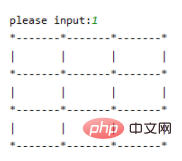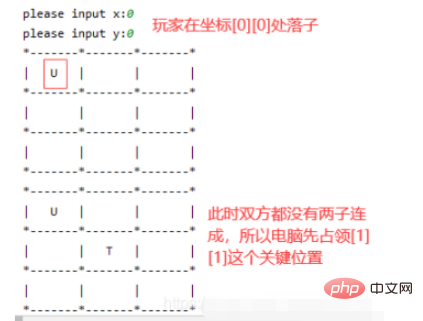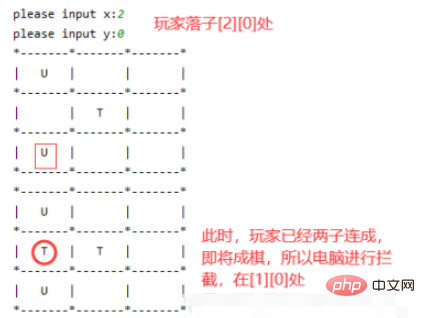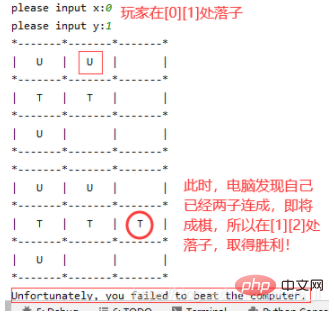How to implement three-piece chess game in python
1. Basic process
The implementation logic of the three-piece chess game is as follows:
1. Create an initialized 3*3 chessboard;
2. The player holds the U piece and moves the piece first;
3. Determination of victory or defeat [win, loss, draw], if the outcome is not decided, continue as follows
4. The computer holds the T piece and makes a move;
5. Determination of victory or defeat, if the victory is If the result is negative, continue from step 2
2. Basic steps
1. Menu interface
Select 1 to start the game, and select 2 to exit the game
def menu():
print('-'*20)
print('1---------------begin')
print('2---------------exit')
print('please select begin or exit')
print('-' * 20)
while(1):
select = input('please input:')
if select == '1':
begin_games()
pass
elif select == '2':
print('exit the game')
break
#pass
pass2. Initialize the chessboard and print the chessboard
The three-piece chess board is a 3*3 square matrix and is stored in a list in python.
chess_board = [[0, 0, 0], [0, 0, 0], [0, 0, 0]]
So how to print out this storage list and turn it into a chessboard?
def init_cheaa_board(chess_board): #先对列表进行初始化
for i in range(MAX_ROW):
for j in range(MAX_COL):
chess_board[i][j] = ' '
pass
def print_chess_board(chess_board): #棋盘打印
print('*'+'-'*7+'*'+'-'*7+'*'+'-'*7+'*')
for i in range(MAX_ROW):
print('|'+' '*3+chess_board[i][0]+' '*3+'|'+' '*3+chess_board[i][1]+' '*3+'|'+' '*3+chess_board[i][2]+' '*3+'|')
print('*' + '-' * 7 + '*' + '-' * 7 + '*' + '-' * 7 + '*')
pass
pass
3. Player’s move
The player selects the horizontal and vertical coordinates of the move on the 3*3 chessboard. The coordinate point needs to meet the following requirements: 1. The point is within the chessboard; 2. The point has not yet been placed.
def player_first(chess_board):
while(1):
x = int(input('please input x:'))
y = int(input('please input y:'))
if(chess_board[x][y] != ' '): #若已被置子,则重新选择坐标
print('This position is already occupied!')
pass
elif(x >= MAX_ROW or y >= MAX_COL or x < 0 or y < 0): #所选坐标超出棋盘范围,重新选择坐标
print('This position is beyond the chessboard!')
pass
else: #若坐标可以落子,则将该坐标置为玩家的棋子U
chess_board[x][y] = 'U'
print_chess_board(chess_board)
#return x,y
break
pass
pass4. Computer placement
Computer placement algorithm:
4.1. First check the chessboard to see if there are two consecutive pieces on the chessboard occupied by the computer. The state of chess. If it already exists, get the coordinate point that can promote victory and make a move T;
4.2. If 4.1 is not satisfied, check the chessboard again to see if there are already two pieces in a row on the board that the player has occupied. The state of becoming or about to become a chess piece. If it already exists, get the coordinate point where the player is about to win, and move the T to intercept;
4.3. If 4.1 and 4.2 are not satisfied, select a favorable point on the computer side to make the move;
A. First determine whether the central position [1][1] is occupied. If not, this is the most advantageous point. When the [1][1] point is occupied, the player's four horizontal, vertical, diagonal, and sub-diagonal lines are blocked;
B, the secondary advantageous points are the four on the 3*3 chessboard Corner, each corner occupied will block the player's three routes;
C. The last advantageous point is the center of each side, which will block the player's two routes;
def Intercept_player(chess_board,key):
count2 = 0
index2 = []
intercept_index = {'x':-1,'y':-1}
for i in range(MAX_ROW):
index = []
count = 0
count1 = 0
index1 = []
allindex = [0,1,2]
for j in range(MAX_ROW):
if(chess_board[i][j] == key): #每一行的玩家落子情况
count += 1
index.append(j)
if(chess_board[j][i] == key): #每一列的玩家落子情况
#print('j'+str(j)+',i'+str(i)+'='+chess_board[j][i])
count1 += 1
index1.append(j)
if (i == j and chess_board[j][i] == key): # 在主对角线中的玩家落子情况
count2 += 1
index2.append(j)
if(count == 2): #在每一行中 获取具体的可以拦截的位置坐标 需要排除掉已经填充的位置
result = list(set(allindex).difference(set(index)))
result = result[0]
if(chess_board[i][result] == ' '): #当这个位置可以进行拦截时,进行坐标返回
#return i,result
intercept_index['x'] = i
intercept_index['y'] = result
return intercept_index
#print(count1,'------->',index1)
if (count1 == 2): # 在每一列中 获取具体的可以拦截的位置坐标 需要排除掉已经填充的位置
result = list(set(allindex).difference(set(index1)))
result = result[0]
#print('count1==2,result:',result)
if (chess_board[result][i] == ' '): # 当这个位置可以进行拦截时,进行坐标返回
intercept_index['x'] = result
intercept_index['y'] = i
return intercept_index
#return i, result
if (count2 == 2): # 在主对角线上 获取具体的可以拦截的位置坐标 需要排除掉已经填充的位置
result = list(set(allindex).difference(set(index2)))
result = result[0]
if (chess_board[i][result] == ' '): # 当这个位置可以进行拦截时,进行坐标返回
intercept_index['x'] = i
intercept_index['y'] = result
return intercept_index
#return i, result
count3 = 0
if(chess_board[0][2] == key):
count3 += 1
if (chess_board[1][1] == key):
count3 += 1
if (chess_board[2][0] == key):
count3 += 1
if(count3 == 2):
if(chess_board[0][2] == ' '):
intercept_index['x'] = 0
intercept_index['y'] = 2
elif (chess_board[1][1] == ' '):
intercept_index['x'] = 1
intercept_index['y'] = 1
elif (chess_board[2][0] == ' '):
intercept_index['x'] = 2
intercept_index['y'] = 0
return intercept_index
def computer_second(chess_board): #电脑智能出棋
#1、先检查一下电脑是否两子成棋 若已有,则获取空位置坐标 自己先成棋
intercept_index = Intercept_player(chess_board, 'T')
if (intercept_index['x'] == -1 and intercept_index['y'] == -1):
pass
else: # 电脑可落子
x = intercept_index['x']
y = intercept_index['y']
chess_board[x][y] = 'T'
return
#2、若玩家快成棋 则先进行拦截
intercept_index = Intercept_player(chess_board,'U') #若玩家已经两子成棋 则获取空位置的坐标
#print('intercept_index---:')
#print(intercept_index)
if(intercept_index['x'] == -1 and intercept_index['y'] == -1):
pass
else: #电脑可落子
x = intercept_index['x']
y = intercept_index['y']
chess_board[x][y] = 'T'
return
#3、如果没有,则电脑端排棋 以促进成棋
#3.1、 占领中心位置 如若中心位置[1,1]未被占领
if(chess_board[1][1] == ' '):
chess_board[1][1] = 'T'
return
#3.2、 占领四角位置 若[0,0] [0,2] [2,0] [2,2]未被占领
if (chess_board[0][0] == ' '):
chess_board[0][0] = 'T'
return
if (chess_board[0][2] == ' '):
chess_board[0][2] = 'T'
return
if (chess_board[2][0] == ' '):
chess_board[2][0] = 'T'
return
if (chess_board[2][2] == ' '):
chess_board[2][2] = 'T'
return
# 3.3、 占领每一边中心位置 若[0,1] [1,0] [1,2] [2,1]未被占领
if (chess_board[0][1] == ' '):
chess_board[0][1] = 'T'
return
if (chess_board[1][0] == ' '):
chess_board[1][0] = 'T'
return
if (chess_board[1][2] == ' '):
chess_board[1][2] = 'T'
return
if (chess_board[2][1] == ' '):
chess_board[2][1] = 'T'
return5. Win or Lose Determination
Final result: Lose, win, draw D
Determination process: Determine whether player U or computer T connects three pieces on each horizontal line, vertical line, and diagonal line , if so, that side wins; when the entire chess surface is occupied but neither the player nor the computer succeeds, it means a draw.
def chess_board_isfull(chess_board): #判断棋盘是否填充满
for i in range(MAX_ROW):
if (' ' in chess_board[i]):
return 0
return 1
pass
def Win_or_lose(chess_board):
isfull = chess_board_isfull(chess_board)
for i in range(MAX_ROW): #每一列的判断
if( chess_board[0][i] == chess_board[1][i] == chess_board[2][i]):
return chess_board[0][i]
pass
pass
for i in range(MAX_ROW): # 每一行的判断
if( chess_board[i][0] == chess_board[i][1] == chess_board[i][2]):
return chess_board[i][0]
pass
pass
if (chess_board[0][0] == chess_board[1][1] == chess_board[2][2]): # 判断棋盘正对角线
return chess_board[0][0]
if (chess_board[0][2] == chess_board[1][1] == chess_board[2][0]): # 判断棋盘反对角线
return chess_board[0][2]
if isfull:
return 'D' # 经过以上的判断,都不满足(既没赢也没输),但是棋盘也已经填充满,则说明和棋
else:
return ' '3. Overall code
# coding=utf-8import random
MAX_ROW = 3
MAX_COL = 3
#array = ['0','0','0']
chess_board = [[0, 0, 0], [0, 0, 0], [0, 0, 0]] #[array] * 3
def init_cheaa_board(chess_board):
for i in range(MAX_ROW):
for j in range(MAX_COL):
chess_board[i][j] = ' '
pass
def print_chess_board(chess_board):
print('*'+'-'*7+'*'+'-'*7+'*'+'-'*7+'*')
for i in range(MAX_ROW):
print('|'+' '*3+chess_board[i][0]+' '*3+'|'+' '*3+chess_board[i][1]+' '*3+'|'+' '*3+chess_board[i][2]+' '*3+'|')
print('*' + '-' * 7 + '*' + '-' * 7 + '*' + '-' * 7 + '*')
pass
pass
def player_first(chess_board):
while(1):
x = int(input('please input x:'))
y = int(input('please input y:'))
if(chess_board[x][y] != ' '):
print('This position is already occupied!')
pass
elif(x >= MAX_ROW or y >= MAX_COL or x < 0 or y < 0):
print('This position is beyond the chessboard!')
pass
else:
chess_board[x][y] = 'U'
print_chess_board(chess_board)
#return x,y
break
pass
pass
def chess_board_isfull(chess_board): #判断棋盘是否填充满
for i in range(MAX_ROW):
if (' ' in chess_board[i]):
return 0
return 1
pass
def Win_or_lose(chess_board):
isfull = chess_board_isfull(chess_board)
for i in range(MAX_ROW): #每一列的判断
if( chess_board[0][i] == chess_board[1][i] == chess_board[2][i]):
return chess_board[0][i]
pass
pass
for i in range(MAX_ROW): # 每一行的判断
if( chess_board[i][0] == chess_board[i][1] == chess_board[i][2]):
return chess_board[i][0]
pass
pass
if (chess_board[0][0] == chess_board[1][1] == chess_board[2][2]): # 判断棋盘正对角线
return chess_board[0][0]
if (chess_board[0][2] == chess_board[1][1] == chess_board[2][0]): # 判断棋盘反对角线
return chess_board[0][2]
if isfull:
return 'D' # 经过以上的判断,都不满足(既没赢也没输),但是棋盘也已经填充满,则说明和棋
else:
return ' '
def computer_second_random(chess_board): #电脑随机出棋
while(1):
x = random.randint(0,2)
y = random.randint(0,2)
if(chess_board[x][y] != ' '):
continue
else:
chess_board[x][y] = 'T'
break
def Intercept_player(chess_board,key):
count2 = 0
index2 = []
intercept_index = {'x':-1,'y':-1}
for i in range(MAX_ROW):
index = []
count = 0
count1 = 0
index1 = []
allindex = [0,1,2]
for j in range(MAX_ROW):
if(chess_board[i][j] == key): #每一行的玩家落子情况
count += 1
index.append(j)
if(chess_board[j][i] == key): #每一列的玩家落子情况
#print('j'+str(j)+',i'+str(i)+'='+chess_board[j][i])
count1 += 1
index1.append(j)
if (i == j and chess_board[j][i] == key): # 在主对角线中的玩家落子情况
count2 += 1
index2.append(j)
if(count == 2): #在每一行中 获取具体的可以拦截的位置坐标 需要排除掉已经填充的位置
result = list(set(allindex).difference(set(index)))
result = result[0]
if(chess_board[i][result] == ' '): #当这个位置可以进行拦截时,进行坐标返回
#return i,result
intercept_index['x'] = i
intercept_index['y'] = result
return intercept_index
#print(count1,'------->',index1)
if (count1 == 2): # 在每一列中 获取具体的可以拦截的位置坐标 需要排除掉已经填充的位置
result = list(set(allindex).difference(set(index1)))
result = result[0]
#print('count1==2,result:',result)
if (chess_board[result][i] == ' '): # 当这个位置可以进行拦截时,进行坐标返回
intercept_index['x'] = result
intercept_index['y'] = i
return intercept_index
#return i, result
if (count2 == 2): # 在主对角线上 获取具体的可以拦截的位置坐标 需要排除掉已经填充的位置
result = list(set(allindex).difference(set(index2)))
result = result[0]
if (chess_board[i][result] == ' '): # 当这个位置可以进行拦截时,进行坐标返回
intercept_index['x'] = i
intercept_index['y'] = result
return intercept_index
#return i, result
count3 = 0
if(chess_board[0][2] == key):
count3 += 1
if (chess_board[1][1] == key):
count3 += 1
if (chess_board[2][0] == key):
count3 += 1
if(count3 == 2):
if(chess_board[0][2] == ' '):
intercept_index['x'] = 0
intercept_index['y'] = 2
elif (chess_board[1][1] == ' '):
intercept_index['x'] = 1
intercept_index['y'] = 1
elif (chess_board[2][0] == ' '):
intercept_index['x'] = 2
intercept_index['y'] = 0
return intercept_index
def computer_second(chess_board): #电脑智能出棋
#1、先检查一下电脑是否两子成棋 若已有,则获取空位置坐标 自己先成棋
intercept_index = Intercept_player(chess_board, 'T')
if (intercept_index['x'] == -1 and intercept_index['y'] == -1):
pass
else: # 电脑可落子
x = intercept_index['x']
y = intercept_index['y']
chess_board[x][y] = 'T'
return
#2、若玩家快成棋 则先进行拦截
intercept_index = Intercept_player(chess_board,'U') #若玩家已经两子成棋 则获取空位置的坐标
#print('intercept_index---:')
#print(intercept_index)
if(intercept_index['x'] == -1 and intercept_index['y'] == -1):
pass
else: #电脑可落子
x = intercept_index['x']
y = intercept_index['y']
chess_board[x][y] = 'T'
return
#3、如果没有,则电脑端排棋 以促进成棋
#3.1、 占领中心位置 如若中心位置[1,1]未被占领
if(chess_board[1][1] == ' '):
chess_board[1][1] = 'T'
return
#3.2、 占领四角位置 若[0,0] [0,2] [2,0] [2,2]未被占领
if (chess_board[0][0] == ' '):
chess_board[0][0] = 'T'
return
if (chess_board[0][2] == ' '):
chess_board[0][2] = 'T'
return
if (chess_board[2][0] == ' '):
chess_board[2][0] = 'T'
return
if (chess_board[2][2] == ' '):
chess_board[2][2] = 'T'
return
# 3.3、 占领每一边中心位置 若[0,1] [1,0] [1,2] [2,1]未被占领
if (chess_board[0][1] == ' '):
chess_board[0][1] = 'T'
return
if (chess_board[1][0] == ' '):
chess_board[1][0] = 'T'
return
if (chess_board[1][2] == ' '):
chess_board[1][2] = 'T'
return
if (chess_board[2][1] == ' '):
chess_board[2][1] = 'T'
return
def begin_games():
global chess_board
init_cheaa_board(chess_board)
result = ' '
while(1):
print_chess_board(chess_board)
player_first(chess_board)
result = Win_or_lose(chess_board)
if(result != ' '):
break
else: #棋盘还没满,该电脑出棋
#computer_second_random(chess_board)
computer_second(chess_board)
result = Win_or_lose(chess_board)
if (result != ' '):
break
print_chess_board(chess_board)
if (result == 'U'):
print('Congratulations on your victory!')
elif (result == 'T'):
print('Unfortunately, you failed to beat the computer.')
elif (result == 'D'):
print('The two sides broke even.')
def menu():
print('-'*20)
print('1---------------begin')
print('2---------------exit')
print('please select begin or exit')
print('-' * 20)
while(1):
select = input('please input:')
if select == '1':
begin_games()
pass
elif select == '2':
print('exit the game')
break
#pass
pass
if __name__ == "__main__":
menu()
pass4. Result display
4.1 The following screenshot shows the process of computer interception, occupying a favorable position, and taking the lead in making a move



The above is the detailed content of How to implement three-piece chess game in python. For more information, please follow other related articles on the PHP Chinese website!

Hot AI Tools

Undresser.AI Undress
AI-powered app for creating realistic nude photos

AI Clothes Remover
Online AI tool for removing clothes from photos.

Undress AI Tool
Undress images for free

Clothoff.io
AI clothes remover

Video Face Swap
Swap faces in any video effortlessly with our completely free AI face swap tool!

Hot Article

Hot Tools

Notepad++7.3.1
Easy-to-use and free code editor

SublimeText3 Chinese version
Chinese version, very easy to use

Zend Studio 13.0.1
Powerful PHP integrated development environment

Dreamweaver CS6
Visual web development tools

SublimeText3 Mac version
God-level code editing software (SublimeText3)

Hot Topics
 PHP and Python: Different Paradigms Explained
Apr 18, 2025 am 12:26 AM
PHP and Python: Different Paradigms Explained
Apr 18, 2025 am 12:26 AM
PHP is mainly procedural programming, but also supports object-oriented programming (OOP); Python supports a variety of paradigms, including OOP, functional and procedural programming. PHP is suitable for web development, and Python is suitable for a variety of applications such as data analysis and machine learning.
 Choosing Between PHP and Python: A Guide
Apr 18, 2025 am 12:24 AM
Choosing Between PHP and Python: A Guide
Apr 18, 2025 am 12:24 AM
PHP is suitable for web development and rapid prototyping, and Python is suitable for data science and machine learning. 1.PHP is used for dynamic web development, with simple syntax and suitable for rapid development. 2. Python has concise syntax, is suitable for multiple fields, and has a strong library ecosystem.
 PHP and Python: A Deep Dive into Their History
Apr 18, 2025 am 12:25 AM
PHP and Python: A Deep Dive into Their History
Apr 18, 2025 am 12:25 AM
PHP originated in 1994 and was developed by RasmusLerdorf. It was originally used to track website visitors and gradually evolved into a server-side scripting language and was widely used in web development. Python was developed by Guidovan Rossum in the late 1980s and was first released in 1991. It emphasizes code readability and simplicity, and is suitable for scientific computing, data analysis and other fields.
 Python vs. JavaScript: The Learning Curve and Ease of Use
Apr 16, 2025 am 12:12 AM
Python vs. JavaScript: The Learning Curve and Ease of Use
Apr 16, 2025 am 12:12 AM
Python is more suitable for beginners, with a smooth learning curve and concise syntax; JavaScript is suitable for front-end development, with a steep learning curve and flexible syntax. 1. Python syntax is intuitive and suitable for data science and back-end development. 2. JavaScript is flexible and widely used in front-end and server-side programming.
 Can vs code run in Windows 8
Apr 15, 2025 pm 07:24 PM
Can vs code run in Windows 8
Apr 15, 2025 pm 07:24 PM
VS Code can run on Windows 8, but the experience may not be great. First make sure the system has been updated to the latest patch, then download the VS Code installation package that matches the system architecture and install it as prompted. After installation, be aware that some extensions may be incompatible with Windows 8 and need to look for alternative extensions or use newer Windows systems in a virtual machine. Install the necessary extensions to check whether they work properly. Although VS Code is feasible on Windows 8, it is recommended to upgrade to a newer Windows system for a better development experience and security.
 How to run sublime code python
Apr 16, 2025 am 08:48 AM
How to run sublime code python
Apr 16, 2025 am 08:48 AM
To run Python code in Sublime Text, you need to install the Python plug-in first, then create a .py file and write the code, and finally press Ctrl B to run the code, and the output will be displayed in the console.
 Can visual studio code be used in python
Apr 15, 2025 pm 08:18 PM
Can visual studio code be used in python
Apr 15, 2025 pm 08:18 PM
VS Code can be used to write Python and provides many features that make it an ideal tool for developing Python applications. It allows users to: install Python extensions to get functions such as code completion, syntax highlighting, and debugging. Use the debugger to track code step by step, find and fix errors. Integrate Git for version control. Use code formatting tools to maintain code consistency. Use the Linting tool to spot potential problems ahead of time.
 How to run python with notepad
Apr 16, 2025 pm 07:33 PM
How to run python with notepad
Apr 16, 2025 pm 07:33 PM
Running Python code in Notepad requires the Python executable and NppExec plug-in to be installed. After installing Python and adding PATH to it, configure the command "python" and the parameter "{CURRENT_DIRECTORY}{FILE_NAME}" in the NppExec plug-in to run Python code in Notepad through the shortcut key "F6".






